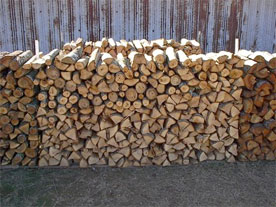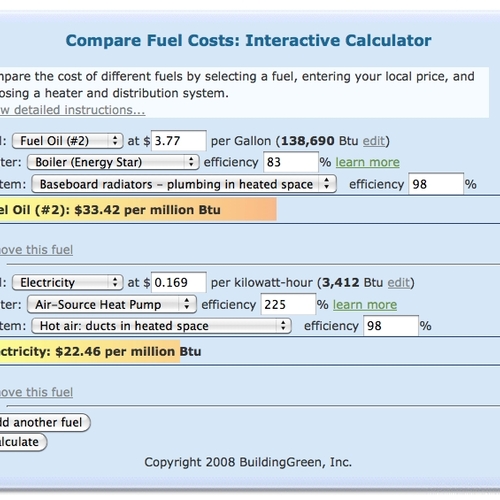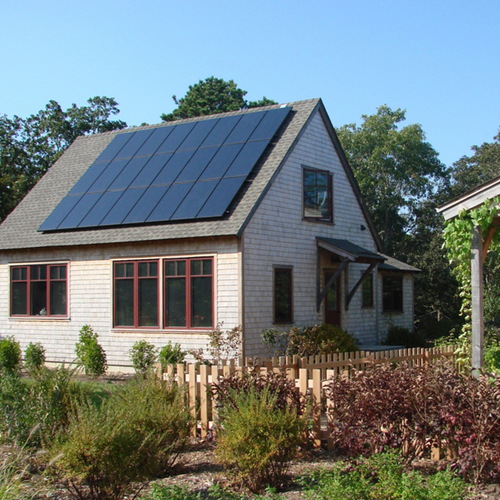
While energy prices have dropped from their record highs a few months ago, many area residents are still wondering how they’ll pay for heat this winter. The most common fuel in northern New England, heating oil, is still priced at over $4.00 per gallon.
But how does the price of oil compare with the price of other fuels and electricity? That sounds like a simple enough question, but it’s actually fairly complicated.
For starters, different fuels are sold in different units. Heating oil, kerosene, and propane are sold by the gallon; natural gas by the hundred cubic foot (ccf) or therm (100,000 Btus); firewood by the cord; wood pellets and coal by the ton; and electricity by the kilowatt-hour (kWh).
Second, the amount of useful heat obtained from a given fuel depends on how efficiently it’s burned. Combustion efficiency varies widely—from as low as 30% for the worst of the outdoor wood boilers to over 95% for a top-efficiency, condensing gas boiler. Baseboard electric-resistance heat is 100% efficient—since the electrons you’re paying for in the electric current are converted entirely into heat. Heat pump efficiencies are much higher (typically 200-300%), because electricity is used for moving heat from one place to another, rather than being converted directly into heat. Note that these electric heat efficiencies don’t account for the “upstream” energy costs of electricity generation, such as the waste heat at a coal or nuclear power plant—but for the purposes of comparing your heating costs, that doesn’t matter.)
To further complicate fuel cost comparisons, a third factor is how efficiently heat is distributed. With electric baseboard radiators, the heat is produced right in the room, so the distribution is 100% efficient. Baseboard hot water (hydronic) heat is also usually very efficient, though uninsulated hot water pipes running through an unheated basement can lower that efficiency to some extent. With a hot-air furnace and ducts to carry the heat, however, the distribution efficiency can be quite low, especially if poorly insulated, leaky ducts run through an unheated attic or crawl space—distribution efficiency as low as 60-65% is not uncommon.
To calculate the actual delivered efficiency of your heating system, you have to multiply the combustion efficiency by the distribution efficiency. For example, if you have a 78% efficient oil furnace and a relatively leaky duct system running through an unheated attic (65% efficient distribution), your overall efficiency of delivered heat is just over 50% (.78 x .65)—meaning that only half of the energy you’ve paid for is actually being used to keep you warm!
Finally, to compare different fuels (sold, as described above, in different units), you have to convert the costs to an equal basis so you’re comparing apples to apples. The most common standard is dollars per million Btus of delivered heat. The easiest way to do this is with an online calculator like the one our company.
This allows you to enter the cost for a particular fuel, your heating system efficiency, and its distribution efficiency. The end result is a figure in dollars per million Btu that reflects your real costs of delivered heat and allows you to compare that with other options. Say you heat with oil and pay $4.40 per gallon (roughly today’s cash price in Brattleboro), using an Energy Star boiler (83% efficient) and hot water baseboard distribution (98% efficient). Your cost of delivered heat with these assumptions will be $39.00 per million Btu. By comparison, electric baseboard heat at the CVPS rate of 12.3¢/kWh converts to $36.05 per million Btu of delivered heat—that’s 8% lower cost for electric heat! Using a heat pump with a coefficient of performance of 2.0 (200% efficient) and ducts fully within the insulated house envelope drops the cost of delivered heat to $18.39 per million Btu. And firewood, at $250/cord burned in an EPA-compliant wood stove (70% efficient), converts to just $16.23 per million Btu of delivered heat. The beauty of an online calculator is that you can quickly and easily vary any of the inputs to compare lots of fuels and heating options.
Keep in mind that energy costs are volatile. It probably doesn’t make sense to rip out your oil boiler and put in electric baseboard heat, because either oil prices could go down, or electricity prices could go up. But if you’re thinking about replacing equipment anyway, you might want to consider an electric heat pump or pellet stove.
Weekly Newsletter
Get building science and energy efficiency advice, plus special offers, in your inbox.















0 Comments
Log in or create an account to post a comment.
Sign up Log in